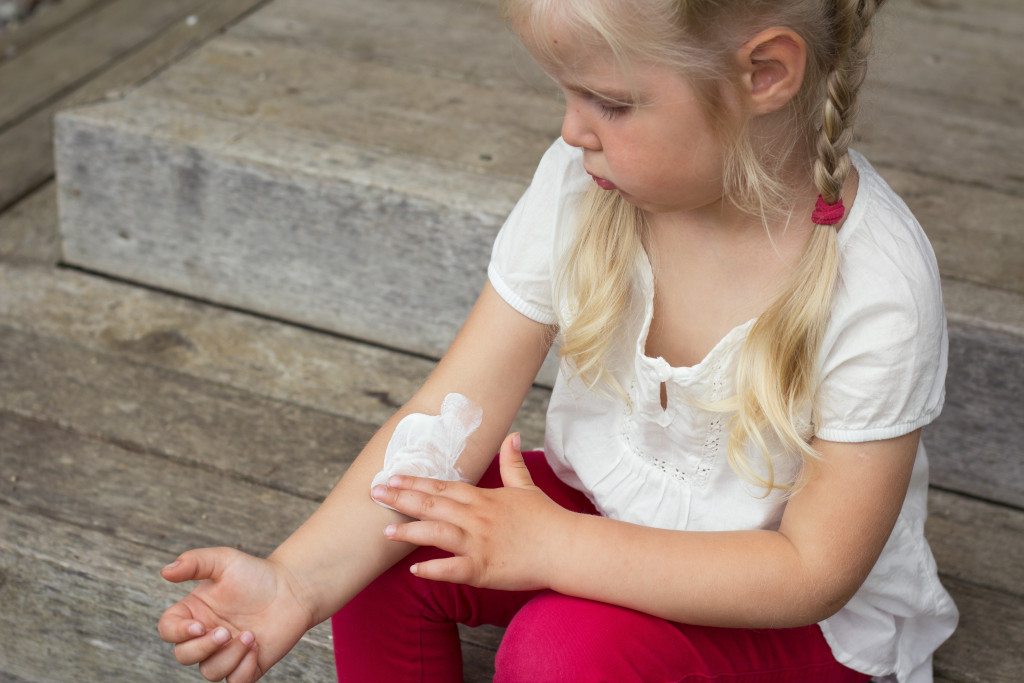
• Cradle cap is a condition in infants where scales form on the scalp due to an overproduction of oil.
• Eczema is a chronic skin condition characterized by red, itchy patches. Treatments involve moisturizing lotions with natural ingredients.
• Warts are caused by the human papillomavirus and can be treated with over-the-counter wart removers, cryotherapy, laser therapy, or surgery.
• Ringworm is an infection of the skin caused by a fungus that can be treated with antifungal creams or oral medications.
• General tips for keeping your child's skin healthy include hydrating, protecting from the sun, and maintaining a healthy diet.
Many parents might be surprised to learn that skin conditions are commonplace in young children. From cradle cap to eczema, kids can develop a variety of skin problems. It's important for parents to become familiar with the signs and symptoms of common skin conditions so that they can get their child medical attention if needed. Read on to find out what common skin conditions your child may experience—and how you can treat them.
Cradle Cap
Cradle cap is a condition where scales form on the scalp due to an overproduction of oil in the skin cells. It usually appears during infancy and affects both boys and girls equally. Cradle cap is harmless, but it can cause discomfort for babies who have sensitive scalps.
To treat cradle cap, use a gentle shampoo with natural ingredients like tea tree oil or chamomile extract. Massage the shampoo onto the scalp and let it sit for ten minutes before rinsing it off with warm water. Doing this once or twice a week should help alleviate any symptoms associated with cradle cap.
Eczema

Eczema is one of the most common skin conditions among young children. It's a chronic condition characterized by red, itchy patches on the skin that can also blister and weep fluid when scratched too much or too often.
Buy an eczema lotion if your child has eczema. Look for lotions with natural ingredients like beeswax, which have skin-soothing properties. Applying the daily will help reduce itching and inflammation. It will eventually help the skin heal and become less sensitive over time.
Warts
Warts are small bumps on the skin caused by viruses known as human papillomaviruses (HPV). Warts are widespread among young children because their immune systems are still developing, making them more susceptible to viral infections such as HPV.
Treatment options include over-the-counter wart remover products containing salicylic acid, cryotherapy (freezing off warts), laser therapy (burning off warts), and even surgical removal if necessary. Speak with your doctor about which option may be best for your child's warts before attempting any treatment at home!
Ringworm
Ringworm is an infection of the skin caused by a fungus. It's highly contagious and can be spread through contact with another person, animal, or object that has come into contact with the fungus. It usually appears as red, itchy circles on the skin and can spread to other parts of the body if left untreated.
Treatment for ringworm includes using antifungal creams or taking oral antifungal medications. You should also ensure that any towels, clothing, and bedding used by your child are washed in hot water after each use to prevent the spread of ringworm.
Maintaining healthy skin for children in general
While the skin conditions mentioned above have different and specific ways to treat them, there are some general tips to keep in mind when it comes to keeping your child's skin healthy. Here are some tips you should follow:
Keep your child's skin hydrated
Keeping your child's skin hydrated by using a gentle, unperfumed moisturizer will help reduce itching and irritation. Look for natural ingredients such as aloe vera or coconut oil to soothe the skin.
Protect your child from the sun

The sun's UV rays can be damaging to your child's skin, so it's essential to apply sunscreen whenever they're going outside. Look for a sunscreen with an SPF of 30 or higher and reapply every two hours.
Maintain a healthy diet
A balanced diet full of vitamins, minerals, and antioxidants can help keep your child's skin healthy from the inside out. Put them on a diet rich in fruits and vegetables to ensure that their skin is receiving all the nutrients it needs.
Cleanse regularly
Regularly cleansing your child's skin can help prevent clogged pores, breakouts, and other skin conditions. Look for a mild soap specifically made for children, and use lukewarm water when rinsing off the soap. This will help keep their skin soft and clean without damaging it.
By taking the proper steps to ensure your child has healthy skin, you can prevent many common skin conditions from developing.
Parents need to be aware of the common skin conditions that their children may experience and how they can treat them. From cradle cap to eczema and warts, various treatments are available depending on the condition.
In addition, maintaining healthy skin, in general, is key—hydrate it regularly with gentle moisturizers, protect from UV rays with sunscreen, feed it nutritious foods filled with vitamins and minerals, and cleanse gently with mild soaps. By following these steps, you can help keep your child's skin healthy now—and into the future!




